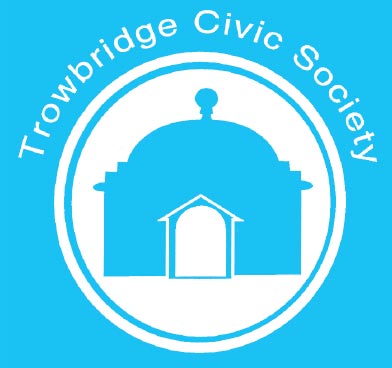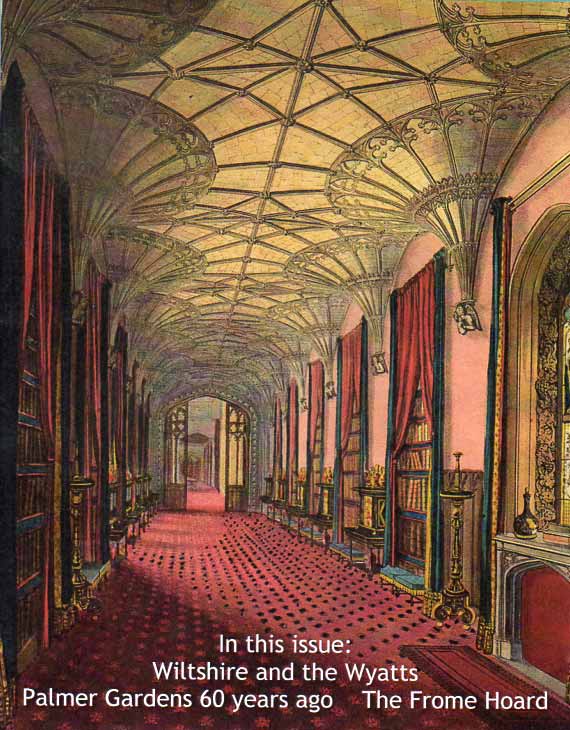| ||||||||||||||||||||
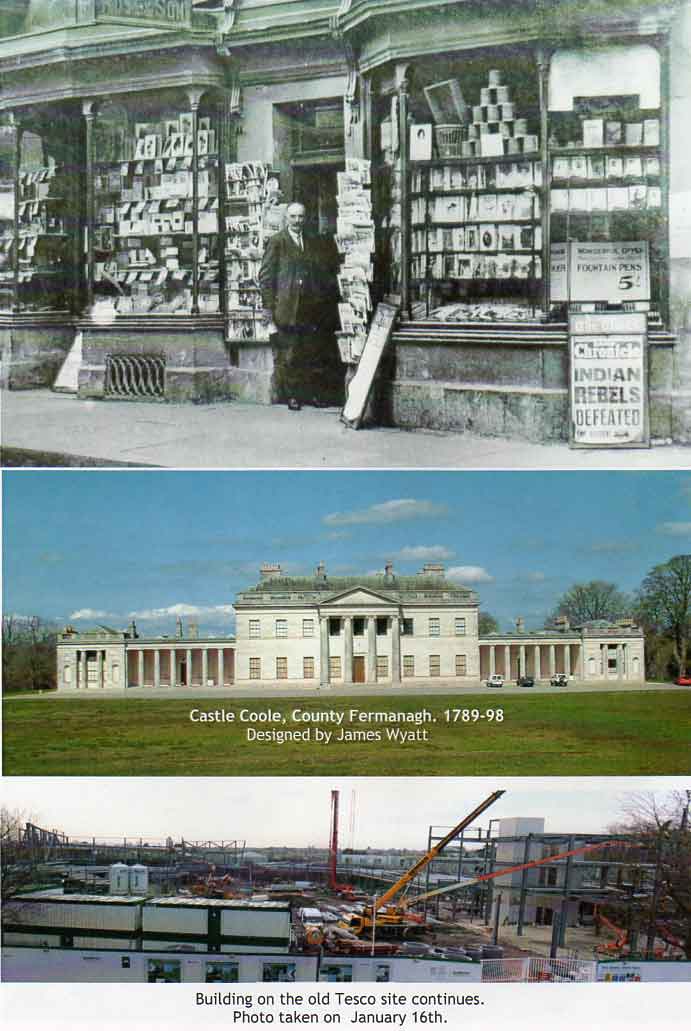 |
Contents
Click on the item to go to the article. |
Editorial CommentAfter we published Roger Newman's account of Rose's shop in Fore Street in the last newsletter, he discovered a photograph in his collection. See page 2. He didn't say when it was taken, so any guesses? Perhaps there are some clues in the window! When was it possible to buy fountain pens for 5 shillings, and when were the Indian rebels defeated? On the front cover is a picture of Fonthill Abbey. This accompanies the first part of an article about the Wyatt Family of architects by Kevin Eames who recently gave an illustrated talk on the subject. In the last issue we asked readers to vote on various “enhancements” or “eyesores” in the town. Mike Johnson comments on the results and also provides us with another of his quizzes. In last summer's issue we celebrated the centenary of Palmer Gardens. Now we have a first hand account of working in the gardens in the early 1950s written by Harry Fox. We have a notice about the Trowbridge Cemetery open day and a short report on the renovation of some of the war graves. |
Forthcoming Events
| 2013 | ||
| Date and Time | Event | Venue or Meeting Point |
| Tuesday 19th March 19:15 |
Annual General Meeting and Talk by Robert Jago entitled “Roll Up! Roll Up!” Trowbridge Fair in Victorian Times | Haden Room, United Church, Church Street, Trowbridge. |
To arrange for a lift or to volunteer to car share please contact Glyn on 755784
FROM THE CHAIRMAN |
When one considers the depressed state of the building industry in the UK it would appear that we in Trowbridge are faring much better than many other parts of the country. It is encouraging to see new building developments taking place across the town and at St Stephen's Place the steelwork of the hotel and cinemas rising above the hoardings.
The biggest town centre site, the former Ushers bottling site, will fill in a huge gap and so far the build looks promising. The Upper Broad Street development is well under way and the York buildings housing development has just begun. These will fill in further gaps in the townscape created by the County Council's ill-conceived Inner Relief Road scheme over thirty years ago.
Selwood Housing must be commended for doing an excellent job in various parts of the town. They have been developing housing on derelict garage sites and unused parcels of land, areas which formerly attracted vandalism and anti-social behaviour. These new homes have done much to improve the surrounding neighbourhoods.
It seems likely that plans for the Bowyer site development will be passed this year which will leave the Peter Black site as the last major eyesore in the town.
Planning Matters |
Since the last Newsletter the following planning decisions have been taken by Wiltshire Council.
- An application to change the use of land at the rear of 162 Devizes Road, Hilperton to a mixture of equestrian and residential was refused because it was outside the defined settlement area of Hilperton and a mobile home was not viewed as being necessary for the applicants. The application was also contrary to advice in the National Planning Policy Framework.
- The Council has agreed to the erection of a double garage and guest accommodation at The Chase, Church Street, Hilperton. The Chase is listed Grade 2 but the development is not intrusive from the road and has been designed to fit its context.
- Permission has been granted to Persimmon Homes to erect 79 homes on land adjacent to the scrap yard in Green Lane, Trowbridge. We felt that the design of the houses was rather bland but at least there were some chimneys on the plans, which is positive.
A new primary school (as part of the same development), incorporating a nursery facility together with associated landscaping, access and parking facilities on the site have also been approved. - Permission has been granted for the erection of two detached four-bed dwellings with garages and associated external works on land west of 60, Bradley Road, plus an additional garage and parking area for number 60.
- The time limit for implementation of planning permission to erect a new two storey block of six flats at the rear of 28 Roundstone Street has been extended.
- Optimisation Developments Ltd has submitted a planning application for the former Bowyers Site, Stallard Street, Trowbridge. The application requests permission for the demolition and alteration of existing buildings and structures for a redevelopment of the site comprising a food store, non-food units, leisure floor space, food and drink floor space, a petrol filling station together with associated car parking, new access and landscaping but no cinema. Watch this space!
Finally, a reminder that planning applications of interest are available for viewing and comment on the Civic Society’s web site.
| Corporate members: | Coleman & Starkey Family Dental Practice, Timbrell Street. The Trowbridge Museum. |
| New Members: | Welcome to three new members: Mr Don Hodgson, Mr & Mrs J Pratten and Mr David Birch |
Wiltshire and the Wyatts |
A Nationally-Famous Architectural Dynasty and Their Local Connections
In the Eighteenth and Nineteenth Centuries, the Wyatt family stood out owing to the number of architects it produced (not to mention the other artists in the family, such as sculptors and painters). Although they were nationally significant, and their work was widely distributed across Britain and Ireland, they also made many contributions to the architecture of Wiltshire - for example in Salisbury, Devizes, Wilton, Swindon, Hilperton, and North Bradley, to name a few places where their influence is to be found. The Wiltshire Buildings Record gives six members of the family as having been active in the county, and in this article and two subsequent ones, I'd like to explore some of their national and local achievements, as well as their relationship to the prevailing intellectual and artistic contexts in which they worked.
James Wyatt was not the first architect in the family, but he was the first with both a national reputation and connections with Wiltshire. He was born near Lichfield, on August 3, 1746, and died on September 4, 1813, in a carriage accident near Marlborough. A fashionable and popular architect, he was seen as a rival to the great Robert Adam, being so sought-after that he had more work than he could cope with, leading at times to difficulties with clients, as can be imagined. As well as attracting a following from private patrons, he was awarded, by royal patronage, public positions such as Surveyor General, and Surveyor of the Ordnance, which also would have led to further private commissions.
Wyatt's early training was in Italy, studying in Venice and in Rome, and soon after his return to England in 1768 he started on the road to fame and popularity by winning a commission to build The Pantheon, assembly rooms on Oxford Street (demolished 1937). His brother Samuel was one of the promoters of the scheme, which may have had some influence on the fact that James, at that time a young and unknown architect, received the commission. The outcome, however, was a building that Horace Walpole (not a relative, so presumably unbiased) described as ‘the most beautiful edifice in England’, and Wyatt's success led to generous patronage from the aristocracy and royalty of the time.
He designed a range of country and town houses for the aristocracy, in the classical style with which he was familiar 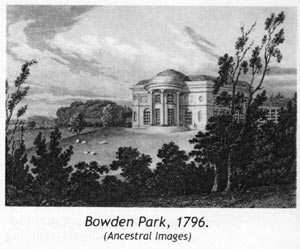 through his training in Italy, and major examples outside London include Heaton Hall near Manchester, Heveningham Hall in Suffolk, and Dodington Park in Gloucestershire. Castle Coole, near Enniskillen, County Fermanagh, in what is now Northern Ireland, (page 2) is a beautifully-balanced composition, described in the Lonely Planet Guide as ‘probably the purest expression of late Cl8th neo-classical architecture in Ireland’. Interestingly, owing to pressure of work, Wyatt is said never to have visited the site, but his designs for the interior furnishings and decoration seemed to be as satisfactory to Lord Belmore, the owner, as was the exterior. Nearer to our own area, Bowden Park near Lacock was completed a couple of years before Castle Coole (1789- 1798), and is described by Pevsner as ‘an exceptionally perfect example of its date’.
through his training in Italy, and major examples outside London include Heaton Hall near Manchester, Heveningham Hall in Suffolk, and Dodington Park in Gloucestershire. Castle Coole, near Enniskillen, County Fermanagh, in what is now Northern Ireland, (page 2) is a beautifully-balanced composition, described in the Lonely Planet Guide as ‘probably the purest expression of late Cl8th neo-classical architecture in Ireland’. Interestingly, owing to pressure of work, Wyatt is said never to have visited the site, but his designs for the interior furnishings and decoration seemed to be as satisfactory to Lord Belmore, the owner, as was the exterior. Nearer to our own area, Bowden Park near Lacock was completed a couple of years before Castle Coole (1789- 1798), and is described by Pevsner as ‘an exceptionally perfect example of its date’.
Wyatt, then, was highly-regarded as one of the most popular architects of the day in the classical style. However, as H.M. Colvin points out, architects of the time were expected also to work in ‘the medieval style’ (i.e. Gothic), and Wyatt's contributions in this field were noteworthy and influential, particularly in Wiltshire - although not without controversy. His renovation of Salisbury Cathedral was ‘ruthless’, according to Pevsner, and he did away with two chapels in the Perpendicular style in addition to removing the bell tower which had stood beside the cathedral since the 12th Century. Inside the cathedral, he ‘tidied it up with depressing orderliness’, which ‘gave it 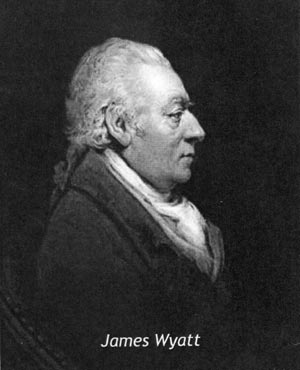 its perfection’ (both inside and out) but gave it also ‘a certain coolness’. These drastic changes earned Wyatt the nickname ‘The Destroyer’, and his ‘improving mania’ was savaged by John Carter in his ‘Pursuits of Architectural Innovation’, published in The Gentleman's Magazine. Carter's persistent criticisms of Wyatt's renovations in Salisbury, as well as in Lichfield, Hereford and Durham, may have been responsible for Wyatt's failure, in 1796, to achieve election to the Society of Antiquaries.
its perfection’ (both inside and out) but gave it also ‘a certain coolness’. These drastic changes earned Wyatt the nickname ‘The Destroyer’, and his ‘improving mania’ was savaged by John Carter in his ‘Pursuits of Architectural Innovation’, published in The Gentleman's Magazine. Carter's persistent criticisms of Wyatt's renovations in Salisbury, as well as in Lichfield, Hereford and Durham, may have been responsible for Wyatt's failure, in 1796, to achieve election to the Society of Antiquaries.
In spite of this setback, Wyatt had by this time established himself as a celebrity in the field of Gothic architecture. Colvin identifies him, in fact, as the architect who brought the style up-to-date, bridging the gap between the ‘rococo Gothic’ of the Cl8th, and the ‘serious medievalism’ of the early Cl9th: ‘Whereas his predecessors had merely Gothicized their elevations by the addition of battlements and pointed windows, Wyatt went further and exploited to the full the picturesque qualities of medieval architecture by irregular grouping and the addition of towers and spires to his silhouettes.’ And we can see this exploitation of the romantic and picturesque qualities of Gothic in Fonthill Abbey, the architectural extravaganza that Wyatt designed for the eccentric William Beckford, and the building which Pevsner described as ‘the most prodigious romantic folly in England’. Beckford, the richest man in England at that time, was a recluse, a writer and a collector, and Wyatt's designs seemed strike a chord.to Beckford had already written the Gothic novel ‘Vathek’, an exotic fantasy of the Orient, drawing on devices such as ghosts, demons, 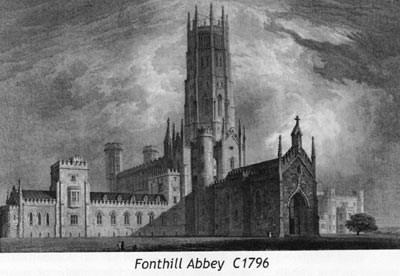 graveyards, supernatural powers and violence in order to raise goose pimples on the spines of its readers, as a good novel of this genre was intended to do. Wyatt's role, perhaps, was to evoke such feelings through architecture, and at Fonthill he succeeded in conjuring an overwhelming vision of medievalised strangeness and power.
graveyards, supernatural powers and violence in order to raise goose pimples on the spines of its readers, as a good novel of this genre was intended to do. Wyatt's role, perhaps, was to evoke such feelings through architecture, and at Fonthill he succeeded in conjuring an overwhelming vision of medievalised strangeness and power.
Fonthill was innovative in that it was structurally Gothic, rather than having Gothic features grafted onto a building that was fundamentally neo-classical. It was designed as a pointed-arched medieval-seeming apparition, picturesquely sited in the Wiltshire countryside, but visitors, on stepping into the entrance hall, gazing upon the vaulted ceiling high above them, and feeling dwarfed by the enormous scale of the architecture, would be expected to experience the thrillingly sublime emotion of terror at their own insignificance. The scale of the building is suggested by the illustration of the entrance hall, with the tiny human figures on the stairway overwhelmed by the height of the walls, windows, pillars and vaulting, and approaching with trepidation the mysterious shadowy depths glimpsed beyond the doorway. This is a building which, as Chris Brooks puts it, makes real the Gothic ‘potential for architectural sensation’, and visitors flocked to Fonthill, to be thrilled by the unbroken perspectives down the galleries and corridors (front cover) - the same unbroken perspectives Wyatt had achieved in his ‘ruthless’ restorations in the cathedrals at Salisbury and Lichfield.
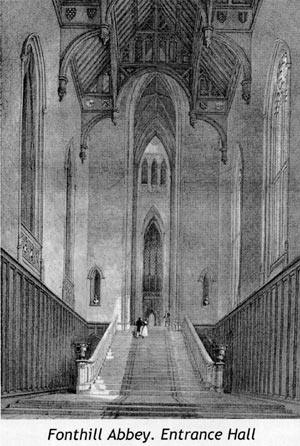 Wyatt#39;s achievement at Fonthill, however, was in the overall structure and effect of the architecture, not in the Gothic detail. For example, the ceiling of the gallery seems to be something like Perpendicular fan vaulting, whereas the entrance hall and front of the abbey are pointed-arched, reminiscent of Early English (but not quite) - although Wyatt himself would probably not have been aware of these terms, which had yet to be attached to the successive styles of English gothic architecture. As Colvin says, the detailing is ‘crude’ and ‘unscholarly’; for a more rigorous, historically-accurate Gothic, we must wait for those Wyatts who came later.
Wyatt#39;s achievement at Fonthill, however, was in the overall structure and effect of the architecture, not in the Gothic detail. For example, the ceiling of the gallery seems to be something like Perpendicular fan vaulting, whereas the entrance hall and front of the abbey are pointed-arched, reminiscent of Early English (but not quite) - although Wyatt himself would probably not have been aware of these terms, which had yet to be attached to the successive styles of English gothic architecture. As Colvin says, the detailing is ‘crude’ and ‘unscholarly’; for a more rigorous, historically-accurate Gothic, we must wait for those Wyatts who came later.
Bibliography
Brooks, C. (1999) The Gothic Revival Phaidon Press
Colvin, H.M. (1954) A Biographical Dictionary of English Architects, 1660-1840 Harvard
Frost, A. (2009) From Classicist to Eclectic: The Stylistic Development of Henry Edmund Goodridge, 1797-1864 University of Bath PhD
Pevsner, N. and Cherry, B. (1975) The Buildings of England: Wiltshire Penguin
Slocombe, P.M. ed (1996) Architects and Building Craftsmen with Work in Wiltshire Wiltshire Buildings Record
Smallman, T. et al (1998) Ireland Lonely Planet
Enhancement or Eyesore? |
In the last issue of the Civic Society Newsletter we asked readers to rate a number of the more recent changes in the Trowbridge townscape by grading them from eyesore to enhancement. Not too many surprises - the Peter Black site and the Bowyers site were clearly the biggest eyesores, followed by the Old bus station site. Perhaps this latter should be a message that developers should make their site fencing more attractive than a huge stretch of white boarding with no relieving pictures or information. The parade of houses in Union Street and Prospect Place were the two seen as enhancements. Both the County Hall extension and the rebuilt Civic Hall were considered near the enhancement end of the scale.
However these results are from very few responses - so is the only real conclusion that Civic Society members aren't that interested in what Trowbridge looks like? If so they are in contrast to the large number of residents who campaigned for the Bowyers development.
Palmer Gardens 60 years ago as I knew it |
[Mr Harry Fox, 86 years old, was born in Trowbridge but went to live at Lulworth Camp in Dorset when his father, a soldier in the Royal Tank Corps, was transferred there. At 14 he became a garden boy at Lulworth Castle. He remained in horticulture until he retired at the age of 70. The highlight of his life was being appointed Landscape Foreman for the Landscape Section of the Wiltshire County Council Highways Department where he covered the whole of Wiltshire, “The biggest garden in the country.” For three years he worked at Palmer Gardens.)
Palmer Gardens was the WCC's Education Department's Demonstration and Supply garden. Miss McCready-Forster was in charge as Rural Studies Organiser and Miss Ethne Freke was her assistant. Jim Cartwright was the head gardener who lived at Erlestoke and came in each day on his motorbike. I lived in Trowbridge and cycled to work. Together we managed the gardens with the help of a couple of gardeners from the local schools when things got a bit overwhelming like mowing or hoeing. There were all grass paths to each plot. All the plots were dug with spades as rotovators were frowned upon and not professional. Our gardener's attire was the traditional corduroy trousers and a pair of heavy hob-nailed boots. Palmer Gardens had only just emerged from the Second World War and I guess it was used mainly for food production so that when I arrived in 1951 as the propagating gardener it was relatively in its early stages and shrubs and trees not so long ago planted. I remember the silence of the garden would be shattered when coach loads of schoolchildren, all excited and chattering, would descend into the garden on a visit. Young rural studies teachers would be booked in to attend our various demonstrations of pruning fruit trees and roses etc and of methods of grafting and budding roses. These were given by Jim and I. The Women's Institute would come in groups to be shown seed sowing and potting up. I used to be absolutely shy in those far off days and my face would redden and hands quiver as I went among them with trays of cups of tea and biscuits. Miss Freke would often call in to do flower arranging with a host of ladies. The flowers and foliage all came from within the gardens. Incidentally, when I married in the June of 1952 I was allowed to have what flowers and foliage I liked to decorate the parish church in Trowbridge for the ceremony.
One of the plots where the café now stands was a large rectangular area called the vegetable demonstration plot. This showed how to sow or plant the various items and the spacing of the rows and thinning out etc and how to mound up potatoes, stick peas with hazel branches and canes for runner beans. As the seasons came around we showed the art of Dutch hoeing in between the rows and of course the digging of the vacant plot. In those days we took great pride in the task of digging and it was my embarrassing task of having to dig the plot with a crowd of people looking on. Jim, the head gardener, told them that they would never see digging carried out by anyone as good as Harry. I was really chuffed at this remark. Some parts of the plot were double dug, that is to say, two spits deep.
All the vegetables that were surplus were eagerly bought up by the firemen who did a 24 hour watch in the fire station that was once over the wall behind the cricket pavilion. Inside the wooden potting/tool shed we did the seed sowing, pricking off and potting up etc. All the gardening tools were arrayed in immaculate lines on the walls and the students who used them had to clean them off and oil them with used sump oil and hang them on their allotted space before they left. We had a small coke stove for winter time as the draughty hut became rather unpleasant. No chairs in those days, we stood all day and no radios were allowed at work. The old hut, by the way, was a First World War army hut brought from the former Sutton Veney army camp. Bet it could tell some wizard tales! Outside, under a corrugated lean-to, was a steam steriliser which was coke heated. We used rotted down turf for soil and we would put a large potato in the top foot of soil to tell when the soil was “cooked”. I can still smell the steamed soil now; it was uplifting. When all was ready we emptied the soil on to a concrete apron alongside and added peat and silver sand and certain fertilizers which were mixed thoroughly following a John Innes formula like John Innes seed compost or JI no. 2 or 3.
Where the car park is now situated there were two large plots, one had rows upon rows of herbaceous plants like Michaelmas daisies in 15 varieties, iris , scabious, rudbeckias, etc all weed killer and fertiliser treatment were taught. 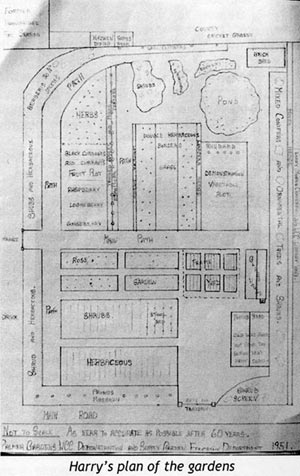 A fruit tree and bush fruit spraying programme was also demonstrated. The top 1/3 of the labelled and the other was 2/3 shrubs, again in many species and all labelled. All the shrubs and herbaceous plants were propagated by seed, cuttings, division etc by Jim and I. All the paths were carefully mown and the edges kept neat with edging shears. Sawn craft was taught and selective shrub plot was the stool-bed. This was planted with gooseberries and black, white and red currants and cut down to almost ground level, then as they produced shoots these were mounded up with soft into which they rooted. Rainy days we were not idle, as pot washing, making up seed trays (wooden), and stencilling labels kept us busy. Another county official was a Miss Dunn from Lackham College who came on a regular visit to Palmer Gardens to take the surplus fruit and vegetables which at times was plentiful. These she used to demonstrate the art of fruit preservation such as bottling and jam making. She also showed how to preserve the vegetables, like runner beans, carrots, peas, beetroot etc for use in winter as freezers then were very rare in homes. All our herbs in the herb plot were put to many uses in her cooking demonstrations which of course were all carried out at Lackham College. The pond was put to use to identify and show the many waterside and pond plants that could also be used in garden designs. Children would turn up with little nets on wooden poles to catch and learn the ponds hidden inhabitants. I was always queasy looking in the pond as several snakes would take up residence in it in the summer and could be seen swimming across it. Once a year we had fun when an inflatable rubber dinghy
was produced and we used it for removing spent foliage of the water lilies etc and for thinning out exuberant plants. Many naughty pranks were carried out and we often ended up rather damp.
A fruit tree and bush fruit spraying programme was also demonstrated. The top 1/3 of the labelled and the other was 2/3 shrubs, again in many species and all labelled. All the shrubs and herbaceous plants were propagated by seed, cuttings, division etc by Jim and I. All the paths were carefully mown and the edges kept neat with edging shears. Sawn craft was taught and selective shrub plot was the stool-bed. This was planted with gooseberries and black, white and red currants and cut down to almost ground level, then as they produced shoots these were mounded up with soft into which they rooted. Rainy days we were not idle, as pot washing, making up seed trays (wooden), and stencilling labels kept us busy. Another county official was a Miss Dunn from Lackham College who came on a regular visit to Palmer Gardens to take the surplus fruit and vegetables which at times was plentiful. These she used to demonstrate the art of fruit preservation such as bottling and jam making. She also showed how to preserve the vegetables, like runner beans, carrots, peas, beetroot etc for use in winter as freezers then were very rare in homes. All our herbs in the herb plot were put to many uses in her cooking demonstrations which of course were all carried out at Lackham College. The pond was put to use to identify and show the many waterside and pond plants that could also be used in garden designs. Children would turn up with little nets on wooden poles to catch and learn the ponds hidden inhabitants. I was always queasy looking in the pond as several snakes would take up residence in it in the summer and could be seen swimming across it. Once a year we had fun when an inflatable rubber dinghy
was produced and we used it for removing spent foliage of the water lilies etc and for thinning out exuberant plants. Many naughty pranks were carried out and we often ended up rather damp.
The glasshouse was rather smaller than we wanted and an awful lot of plants went through it. This was all the seedlings in trays until the time came for them to be hardened off in the heavy Victorian frames in the farmyard. The glasshouse was heated by a small coke-fuelled boiler and this enabled me to acquire some very welcome overtime money. This was when I was on boiler duty at night and had to keep and eye on the fickle weather. I recall leaving the heated Gaumont cinema in Trowbridge and walking up to Palmer Gardens on a freezing night with my girl friend (now wife) and clinkering out the fire in the boiler etc. Yet another member of P G staff was a Frank Miles from Coulston near Erlestoke. He was the itinerant gardener who drove the old flat backed lorry, a Morris Commercial that we had for the gardens. His job was to ferry all the plants, canes, soil etc to the schools all over Wiltshire where they were ordered by Rural Subjects teachers. We would also do gardening tasks at little village schools where they had no gardener. Being 86 years of age in September I think that I am the only one left alive now and I feel sad that such a grand lot of men are lost. If everyone was a gardener the world would be a very pleasant place.
[After 3 years at PG Harry obtained the post of Head Gardener at Binegar Hall in Dorset near Wareham. He “sadly but gratefully left.” ]
Open Day at Trowbridge General Cemetery |
Saturday, 20th April 2013, 10 am to 3 pm
Wiltshire Council is holding an open day at Trowbridge Cemetery on Saturday, 20th April, 2013. This is a new venture for them, and Trowbridge Civic Society is supporting the event, as Trowbridge has an outstanding Victorian cemetery - a treasure for the town and its visitors to appreciate. According to Chris Brooks in ‘Mortal. Remains’, his groundbreaking study of Victorian and Edwardian cemeteries in England, it is, as a whole ‘of remarkable interest and quality, both in its buildings and monuments.’
The cemetery has featured in the Civic Society's Newsletter (Summer 2012), and it has been the focus of a highly-informative tour led by Ken Rogers. The cemetery chapels are listed buildings (Grade II), and the mausoleums and monuments are well worth a visit, also. The architectural quality of the cemetery as a whole is excellent, and Civic Society members who have not yet discovered this important asset to the town are urged to visit soon. All members are encouraged, also, to attend the open day in support of this worthwhile venture.
Renovation of War Graves plot at Trowbridge Cemetery |
The Commonwealth War Graves Commission (CWGC) has completed a full renovation of the war graves plot at Trowbridge Cemetery, Wiltshire. The plot, which contains 19 burials from the two world wars, was completely 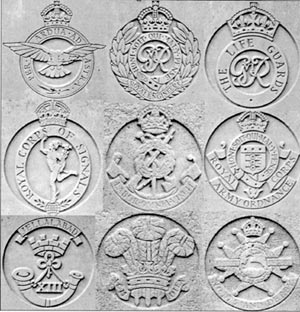 returfed, with new headstone borders also dug and planted. The CWGC worked with Wiltshire Council to ensure that the work was completed as quickly and efficiently as possible, with no disturbance to any planned services or burials at the cemetery. Wiltshire Council described the renovation as a lovely tribute to the people from the Trowbridge area who gave their lives in the two world wars. The work which was part of a bigger project following a general inspection in 2011 of all CWGC sites in the United Kingdom was completed within two days. Trowbridge Cemetery will also receive a CWGC sign that indicates that there are Commonwealth war graves within the cemetery. The sign at Trowbridge is one of a number being put up by the CWGC as part of a project to highlight lesser-known sites containing war graves. This story, dated 19 December 2012, has been taken from the Commonwealth War Graves Commission website (http://www.cwgc.org/.
returfed, with new headstone borders also dug and planted. The CWGC worked with Wiltshire Council to ensure that the work was completed as quickly and efficiently as possible, with no disturbance to any planned services or burials at the cemetery. Wiltshire Council described the renovation as a lovely tribute to the people from the Trowbridge area who gave their lives in the two world wars. The work which was part of a bigger project following a general inspection in 2011 of all CWGC sites in the United Kingdom was completed within two days. Trowbridge Cemetery will also receive a CWGC sign that indicates that there are Commonwealth war graves within the cemetery. The sign at Trowbridge is one of a number being put up by the CWGC as part of a project to highlight lesser-known sites containing war graves. This story, dated 19 December 2012, has been taken from the Commonwealth War Graves Commission website (http://www.cwgc.org/.
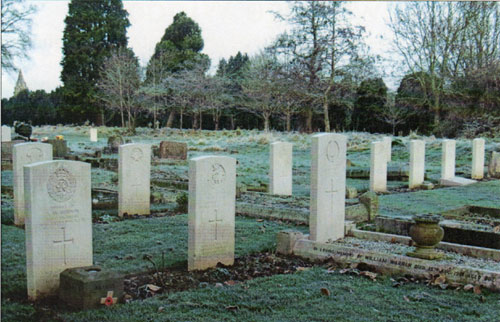
RECENT MEETING: |
The Frome Hoard |
Dave Crisp, a metal detectorist, gave us an entertaining and lively illustrated talk about his discovery of the Frome Hoard in April 2010. The hoard was actually two hoards. Dave, out for a pleasant day's metal detecting, first found some late Roman silver coins just below the surface of a field near Frome. Eventually he found 62. Interestingly, 111 had previously been discovered on the same farm in 1867. He went on searching and then had what he called “a funny signal”. Dave gave a very graphic description of digging through the top soil, then finding sticky yellow clay. In this he 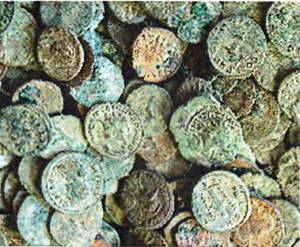 found some more coins, what he called “grots”, which turned out to be small radiate coins, so called because of the radiate crowns that the emperor or ruler on the coin wears. After more digging he discovered the top of a pot at which point he stopped and called in the experts. For three days, the experts, led by archaeologist Alan Graham, excavated a trench, discovering a large pot containing 52,503 coins. It was one of the largest group of coins ever found in Britain and contained the largest group ever found of coins issued during the reign of Carausius who ruled Britain in the third century.
found some more coins, what he called “grots”, which turned out to be small radiate coins, so called because of the radiate crowns that the emperor or ruler on the coin wears. After more digging he discovered the top of a pot at which point he stopped and called in the experts. For three days, the experts, led by archaeologist Alan Graham, excavated a trench, discovering a large pot containing 52,503 coins. It was one of the largest group of coins ever found in Britain and contained the largest group ever found of coins issued during the reign of Carausius who ruled Britain in the third century.
The coins were taken to the British Museum where, for six weeks, a conservator washed and dried them. The majority of coins are made from bronze, but amongst them were 5 solid silver ones. Dave entertained us by discussing how these coins might have found their way in with all the grots. He was similarly amusing discussing why these coins were there in the first place. His idea is that the local community regarded this spot as a holy site and had place these coins there as an offering to the gods to bring good harvests. That would also explain why there were two hoards in this place.
For a time Dave became a celebrity, appearing not only on British television, but also on Japanese TV. The coins were exhibited in the British Museum, Frome Library and are now on permanent display in the Museum of Somerset in Taunton, along with the pot - a greyware kitchen pot, perhaps for oil, olives or other food -in which they were found.
Using only a collection of photographs taken during and after the excavation, Dave was, for me, a thoroughly entertaining, often funny speaker, but he also showed a deep knowledge of the historical background of the times in which the coins were buried.
After the talk we were able to “dig” into and enjoy Ruth's delicious radiates - or biscuits.
Trowbridge Windows |
Do you know where these windows are? Click on the plaque below to reveal the answers.
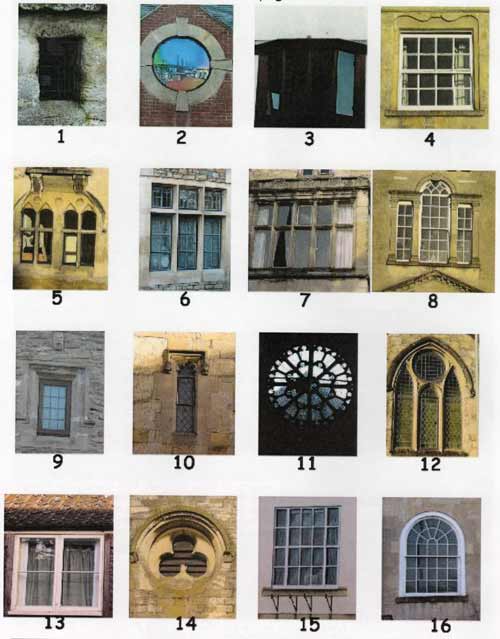 |
| Can you identify them all? Click on the plaque to reveal the answers - no cheating! | 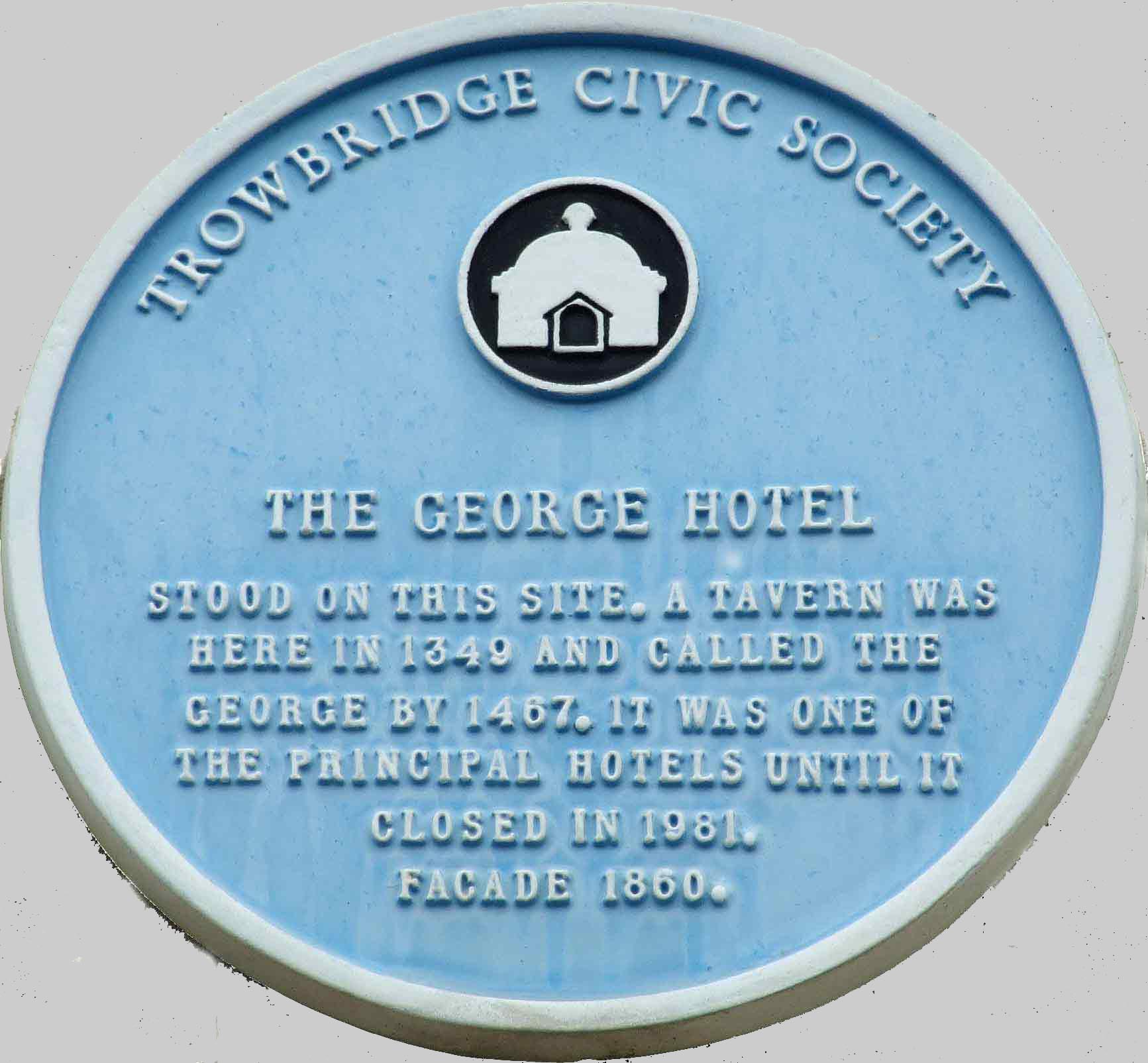 |
